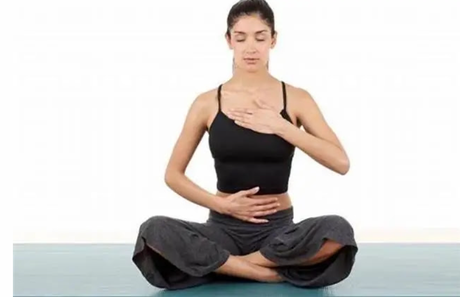Yoga pranayama is a term that refers to a system of breathing techniques that can help us interact with our inner selves on a profound level and, in certain instances, even enable us to achieve spiritual awakening. This is why Pranayama is frequently referred to be a sort of meditation. Because our mind, like a hazy glass of water, can find purity and calm when it is still! Because, believe it or not, Pranayama is more than just a technique for controlling our breathing; it’s a precise science that, when practised correctly, may lead to extraordinary, life-changing effects.
1- Three-Part Breath (Dirga Pranayama)
This Yoga pranayama, a precise exercise, combines three different breathing exercises in which our emphasis goes from the abdomen area to the chest and then to the collarbone region.

Procedure
- Place one hand on your stomach and the other on your chest. Take a big breath in and feel your tummy expand as the fresh air fills your lungs. Continue to breathe deeply and feel your ribcage expand. The breath will eventually reach the tops of your clavicles. 3 to 5 cycles of complete yogic breathing are recommended.
Benefits
- It improves mood by causing endorphins to be released.
- Reduces anxiety and stress
- Stimulates the production of anti-ageing hormones
2- Sama Vritti – breathing in a square box
We attempt to equalise the duration of each inhale and exhalation when executing this Yoga pranayama, and it’s a wonderful action for both the mind and the body since it allows us to rest in a deep, soul-nourishing calm.
Procedure
Inhale deeply for at least four seconds through the nose. For four seconds, hold your breath. Now take a four-second to exhale. Hold your breath for four seconds before repeating the process.
Benefits
This activity is ideal for when we are overwhelmed by stress or feel distant from our bodies and minds.
3- Alternate Nostril Breathing (Nadi Shodhana)
According to Ayurveda, this approach tries to cleanse the Nadis, which are delicate pathways through which our prana flows, an ancient Indian medical system. As a result, when we do Nadi Shodhana, we bring these two energies into harmony in our bodies.
Procedure
Close the right nostril with your thumb and count to four slowly and consciously from the left nostril. Exhale from the right nostril, shut the left nostril with the ring finger, and count to six. Inhale in the same nostril for four seconds, then exhale through the right nostril. You’ve completed the first round by exhaling for six seconds via your left nostril. It can repeat the identical procedure up to four times.
Benefits
- Because it purifies and controls the entire pranic system -activates the frontal brain and the “Ajna” chakra, boosting attention and tranquilly – it’s helpful for practically all imbalances.
- Regular practice may assist in the reduction of depression.
4- Against The Wave: Viloma Pranayama
Viloma Pranayama is a deeply relaxing, stress-relieving practice that practitioners regularly employ to quiet down anxiousness and restore order to our emotional environment.

Procedure
- Inhale slowly and deeply for two seconds through the nose, filling the lungs to half their capacity. Hold your breath for a second, then continue breathing for two more seconds, hold your breath, and repeat until your lungs are totally full of air. Exhale slowly and steadily through the nose. You can go through the process four to five times.
Benefits
This practice is highly recommended for those who suffer from heart disease.
5- ‘Cooling Breath’ Sheetali Pranayama
Since this technique might help the practitioner achieve peace and tranquillity, the name “Sheetali” comes from Sanskrit and means “calm.”
Procedure –
- Open your mouth slightly and roll the sides of your tongue up into a tube shape. Inhale through your mouth and exhale through your mouth when you’ve reached the top of the inhalation. exhale slowly and deeply through your nose. Repeat the exercise as many times as necessary.
Benefits –
- On hot summer days, it’s a lifesaver because it helps us chill down while also calming our muscles and nervous system.
Also Read
Beginners Guide to Yoga for Women
No Time to Practice at a Studio? Unroll Your Mat for a Yoga Class Online with Glo
**SC**
